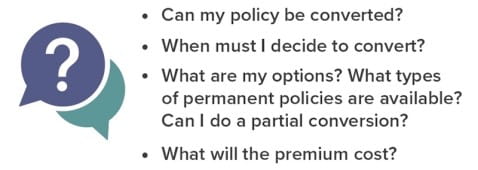Should You Convert Your Term Life to Permanent Life Insurance?
Term life insurance provides life insurance coverage for a specific time period (the term). The face amount of the policy is paid if you die during the term of the policy. When you live longer than the term of coverage, nothing is paid, as there is no cash surrender value. Permanent life insurance provides protection for your entire life, regardless of your age or health, as long as you pay the premium to keep the policy in force.
Usually, term life insurance costs less than permanent life insurance for the same amount of death benefit. Term policies often offer the opportunity to convert to permanent insurance. Here are some reasons why you might consider converting your term life insurance to permanent life insurance.
Your Health Has Changed
Since term life insurance is temporary coverage that will end after a number of years, your circumstances may have changed, warranting life insurance coverage for the rest of your life. Converting term life insurance to permanent life insurance does not require additional underwriting. This allows you to extend your life insurance coverage for the rest of your life without going through a medical exam. This fact is particularly important if your health has changed since the time you purchased the term policy.
Your Financial Circumstances Have Changed
You may have purchased term life insurance because it fit better into your budget. Now you may be able to afford the higher premium cost of a permanent life insurance policy that better fits your insurance needs.
You May Want Cash Value
Most permanent life insurance provides for the accumulation of cash value. Part of the premium goes toward the cost of the death benefit and related policy costs; another part goes toward building cash value. The interest and earnings grow tax deferred until you withdraw the funds and may be part of the income-tax-free death benefit when you die. With most cash-value life insurance, you can borrow against or take withdrawals from your cash-value account, although policy loans and withdrawals can reduce the death benefit.
You Want Funds to Pay for Final Expenses
Final expenses of a last illness and memorial and funeral costs could take quite a bite out of your assets, or worse, the assets of the loved ones you leave behind. You may want to convert some or all of your term life insurance to permanent insurance that can be used to pay for final expenses.
Questions to Ask
If you're thinking about converting your term life insurance to permanent, here are some questions to ask your insurer:

You Want to Leave a Legacy
The tax-free death benefit of a life insurance policy may be a cost-effective way to leave an inheritance to your loved ones. Permanent life insurance can be available no matter when you die, as long as you've kept up with the premium payments.
You May Owe Estate Taxes
Federal estate taxes are owed on estate assets that exceed the federal estate tax exclusion ($11.7 million in 2021). In addition, several states have their own separate estate taxes and exemptions. Those you leave behind can use the death benefit of your life insurance to pay some or all of any applicable estate taxes after your death.
The cost and availability of life insurance depend on factors such as age, health, and the type and amount of insurance purchased. As with most financial decisions, there are expenses associated with the purchase of life insurance. Policies commonly have mortality and expense charges. In addition, if a policy is surrendered prematurely, there may be surrender charges and income tax implications. Withdrawals of the accumulated cash value, up to the amount of the premiums paid, are not subject to income tax. Loans are also free of income tax as long as they are repaid. Loans and withdrawals from a permanent life insurance policy will reduce the policy's cash value and death benefit, and could increase the chance that the policy will lapse, and might result in a tax liability if the policy terminates before the death of the insured. Additional out-of-pocket payments may be needed if actual dividends or investment returns decrease, if you withdraw policy cash values, or if current charges increase. Any guarantees are contingent on the financial strength and claims-paying ability of the issuing insurance company.
Content provided by Forefield for use by Eliot M. Weissberg, CFP®, CFS, of Raymond James Financial Services, Inc., Member FINRA/SIPC. The Investors Center, Inc. is an independent company. The information contained in this report does not purport to be a complete description of the securities, markets, or developments referred to in this material. The information has been obtained from various sources considered to be reliable, but we do not guarantee that the foregoing material is accurate or complete. Any opinions are those of Eliot Weissberg and not necessarily those of RJFS or Raymond James. Expressions of opinion are as of this date and are subject to change without notice.
This information is not intended as a solicitation or an offer to buy or sell any security referred to herein. Past performances may not be indicative of future results. You should discuss any tax or legal matters with the appropriate professional.


